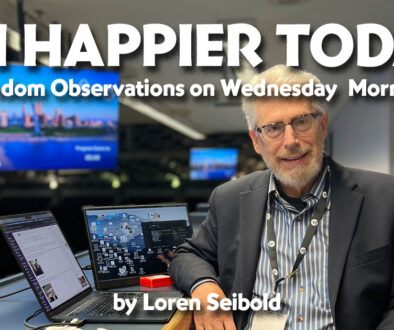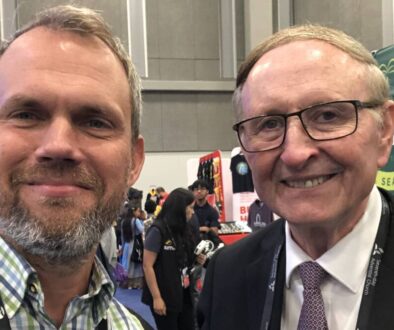The Church, the Machine
by Debbie Hooper | 23 January 2024
I grew up in the Seventh-day Adventist Church, and there are many things about it for which I’m grateful.
But there is also a dark, unhealthy dimension to this organization. Beneath the good work of Adventist hospitals and the Adventist Development and Relief Agency, beneath the church’s excellent education system, beneath individual congregations and the good and godly members, there exists a rigidity and unkindness that is pervasive and entrenched.
I call this aspect of the church “the Machine,” because for all the church’s good qualities, the Machine is willing to run over and crush anything and anyone that appears to threaten it—like a large psychological bulldozer. The Adventist Church has brought much good to the world, but the Machine has caused serious harm.
And the Machine has refused opportunities again and again over the course of its history to change its hurtful ways.
How the Machine works
The conditions that created the Machine are embedded deep in the Adventist DNA. They began with the church’s unique last-days theology, which focuses on two things: threats to Adventism, and the need for members’ unwavering loyalty and obedience.
Ellen White warned that people would forsake the truth in the last days and a shaking would dislodge members from among church ranks. “This peril, above all others, they must guard against; for by receiving false teachers, they would open the door to errors,” wrote Ellen White in The Acts of the Apostles (473).
The need for loyalty has led church leaders to reject anyone who challenges the status quo. They frame it in terms of The Shaking. Church members, trained to put the needs of the church above everything and everyone, accept that the church needn’t account for this dismissive attitude.
Added to the defensive mindset is a preoccupation with persecution that places an unhealthy emphasis on remaining “true.” Mrs White uses the words “martyr” and “martyrdom” over 3,700 times in her writings.
Adventist publishers have followed suit. They supply a continuous stream of books about martyrs who remained faithful to their beliefs to the bitter end. Besides the classic The Great Controversy, with its threats of persecution, there is Unshakeable Faith, by Mark Finley, which tells stories of heroes who stood up to the Catholic Church in the Middle Ages and were “able to sing while burning at the stake”; Impaled, by Ernest H. J Steed, goes into gruesome detail of a South Pacific missionary who was speared and “made the ultimate sacrifice so that others could have eternal life”; and Merikay McLeod’s Now! is still read to classes of children in Adventist schools, inspiring nightmares about the persecution they will experience as Sabbath-keepers in the end times.
In remaining faithful to the one true church that has everything right and has nothing to learn, Adventists have a rationale to simultaneously excuse problems and eject dissenters without scrutinizing either too closely.
The making of the Machine
The Machine grew ever more powerful with each refusal of transparency and reform.
James and Ellen White discarded a long list of colleagues with whom they quarreled: look into the stories of Canright, Ballenger, Kellogg, Jones, and Waggoner. These people were cut adrift, and steps were taken to ensure they could no longer influence the emerging Adventist movement. The orders to do so came directly from God: “I was shown.…” became the rationale for rumor campaigns and spiritual assasination. That’s what happened to Fanny Bolton, a young woman who was central to the Whites’ ministry.
Fanny Bolton was a journalist who had previously worked for a Chicago newspaper before Mrs White offered her employment as an editorial assistant. But Bolton saw inconsistencies that troubled her. In a letter to a friend, Bolton spoke about the excessive rewriting she had to undertake to transform Mrs White’s notes into material for public consumption. Even Ellen’s sermons were filled with
illiteracy in lack of logic, mixed metaphors, lack of connections and climax, and were marked with awkward sentences, platitudes, repetition, and everything that goes to make good literary productions was lacking.
Evidence supports Bolton’s assessment—not to mention White’s extensive borrowing. To Bolton, it didn’t seem ethical for Mrs White to take the full credit for authorship of her published works.
When Bolton spoke of her concerns to others, the Whites and their colleagues attacked her mental, spiritual, and moral adequacy. They questioned her journalistic abilities and challenged her claims that she rewrote, expanded on, and shaped Mrs White’s words. They extolled Mrs White’s writing abilities as far superior to Bolton’s.
Bolton doubted her own motives. What if she was just being egotistical? Her belief in the importance of God’s work caused Bolton painful cognitive dissonance. More than once, she was dismissed by Mrs White, and more than once Fanny apologized and was reinstated. This was invariably followed by another attack of doubt about the ethics of Mrs White’s writings.
And so it went. Bolton was left in a state of mental and emotional turmoil, unable to discern the reality of her situation. In the end, she was admitted to a mental institution where she later died, broken and alone.
This has been repeated since the 1800s whenever concerns were raised by prominent theologians and scholars.
Des Ford
Many Adventists still impugn the character of Bible scholar Desmond Ford, though he was known, even by church leaders, to be an unimpeachable Christian gentleman. Yet some still refer to “the Cult of Des,” as though he had been a sort of David Koresh. An article in ADvindicate implies that he was ignorant and childlike in his understanding of scripture: “…Bible and Spirit of Prophecy quotes that make it clear, almost to a 6-year-old, why his theology was so wrong.”
Yet Ford’s teachings resonated with countless Seventh-day Adventist ministers, teachers, academics, and church members in Australia, New Zealand, Europe, and the United States. Following Ford’s defrocking, many workers were pushed out of church employment for being sympathizers. Others left after losing their faith in church bureaucracy and/or church doctrine.
In the period directly following Glacier View there was a dramatic increase in the attrition rate for Adventist pastors in Australia and New Zealand. Sociologist Dr Harry Ballis in Leaving the Adventist Ministry: A Study of the Process of Exiting documented that while attrition rates were stable in the decades from 1952 to 1980 (50% per decade), in the two decades following Ford’s sacking, 50% of ministers left the ministry each year. This included both young and experienced pastors, new converts as well as second or third generation Adventists.
Again, the Machine obscured these tragic losses of some of the most talented people in the church by framing it as The Shaking: that a charismatic leader had led a mass apostasy of foolish, unthinking followers.
Documents, letters, and eyewitness accounts from attendees at Glacier View in 1980, where Ford was put on trial, provide abundant evidence that Ford’s defrocking was a predetermined outcome. (See On the Way to Glacier View, Volume 6, by Gillian and Desmond Ford, and Peter Dixon’s SDAQ&A interviews with Dr. William G. Johnsson and Dr. Lynden Rogers.) Leaders with an agenda manipulated a process that, had it been approached differently, could have steered the Church towards reform. But even though many delegates felt that Ford’s teachings would indeed contribute positively to the Adventist gospel message, he was expelled and declared apostate.
Perhaps it is true that the more aware you are of hypocrisy, the more you are willing to cover it up. At the very least, Glacier View was as much about power and control for the Machine and those who maintained it as it was about theology.
Conditional salvation
Over 40 years later, the Machine is again in high control mode. Policies, committees, and methods for enforcing compliance now converge on issues of women’s leadership and LGBTQ people, as well as attacking those who question Mrs White, or the investigative judgement, or a six-day creation.
According to General Conference President Ted Wilson, divisions, unions, local conferences, and Adventist schools must unify around a set of rigid beliefs, some of which go against Biblical evidence, science, and conscience. Again, the cry goes up that the slightest deviation from General Conference orthodoxy is evidence of the Shaking, leading the current president to demand recently that anyone who isn’t fully in compliance should just leave.
The Machine uses guilt to manipulate members. Instead of speaking up when they have questions and concerns, Adventists are charged to remain silent and submissive lest they become a stumbling block to others:
Let us not pass judgment on one another any longer, but rather decide never to put a stumbling block or hindrance in the way of a brother (Romans 14:13).
If feeling doubt is a denial of the Holy Spirit’s calling, and Adventists are responsible for other people’s salvation, then salvation becomes conditional on compliance and loyalty.
Who’s the real stumbling block?
Personal doubt has no place in the Adventist Church, and no outlet for it means that it can only be agonizingly internalized. Feelings of insecurity and unworthiness lead to groupthink and making binary judgements about others. Young Adventist musicians and creatives hold back for fear of being called tools of Satan. Preachers, writers, and editors scrupulously avoid appearing to be disloyal, in the process giving up the chance to be transformative voices. Congregants submerge their real thoughts. And the happiest people in Adventism are those who are either there for the social life, or who are not given to questioning.
It’s no wonder that so many questions remain unanswered, so many concerns remain unresolved. The Machine prevails. The Machine says don’t inquire; don’t ask questions; don’t challenge; don’t criticize; don’t disagree; and don’t pursue truth and reality.
Instead, close your eyes. Outsource yourself to the Machine. Vanish, enmesh, fuse, and merge, because you can trust the Machine.
And that is how the Seventh-day Adventist Church Machine became the biggest stumbling block to spiritual growth to Adventists.
 Debbie Hooper writes from the Gold Coast of NSW, Australia.
Debbie Hooper writes from the Gold Coast of NSW, Australia.




